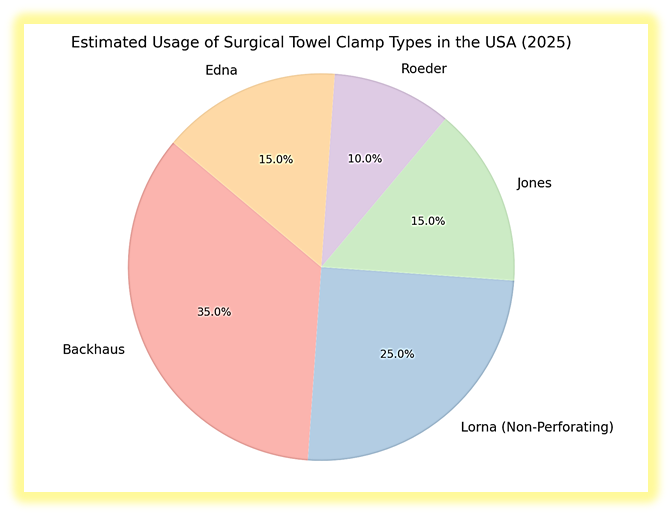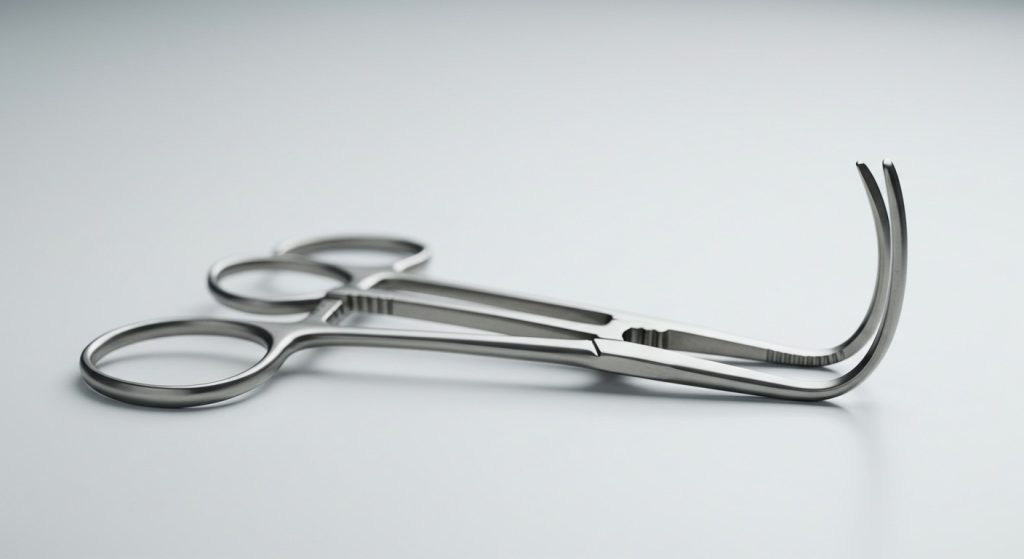How do you think surgical drapes can remain stationary in very delicate operations without falling? Using a small but fundamental instrument, surgical towel clamps, is the best solution. The operating environment in most situations is kept free from environmental pollution, which is a critical step in maintaining the health of the patient by ensuring that the operating room doesn’t cause any distractions to the doctors who are focused on saving lives.
What Are Surgical Towel Clamps?
Surgical towel clamp definition: Towel clamps are specialized instruments used in various surgical procedures and in operating rooms for patients in hospitals to cling drapes and to be able to sterilize the operative field when using these clamps. Made from stainless steel, titanium, or plastic surgical towel clamps, these clamps are produced in different volumes, designs, and functions to meet the exact demands of the surgery. The main use of these instruments is the secure attachment of the surgical drapes, preventing pollution and ensuring the sterile field integrity in the course of the operation.
Main Types of Surgical Towel Clamps with Use-Case Scenarios
There are different types of surgical clamps used in the operating theaters worldwide, each with its specific use and action:
1. Surgical Backhaus Towel Clamp
Is the Backhaus towel clamp a surgical tool? Yes, the Backhaus towel clamp is an instrument with many uses. One of the specific uses is in general surgery. The sharp, curved tips grip the drapes securely and are especially useful in performing large, sterile field necessary operations.
2. Lorna (Non-Perforating) Clamp
Lorna clamps the sharp tip, which is sharp, and inserts it into the drapes, which is why it is not perforating. These are perfect for the operations where the surgeon must use a special hammer for the very thin or fragile draping materials that are on the patient’s body.
3. Jones Towel Clamp
Jones clamps have been innovatively designed with serotinous jaws that grip tightly without the need to puncture the fabric. These are the most commonly used orthopedic and cardiovascular punctures.
4. Roeder Clamp
Roeder clamps are distinctive in that they adopt a loop design of high security and minimal damage to tissues. This product is usually used in gynecological and urological surgeries.
5. Germantown Towel Clamp
Edna clamps are more curved and possess a much neater gripping surface than the previous clamps. These clamps can be applied to surgery situations in a broad range of areas where a firm but not traumatic grip is needed.

How Do You Know Which Towel Clamp to Use?
There are various types of clamps in surgery. The selection of the right towel clamp surgical instrument is dependent on several factors:
- Operation type: The complexity and nature of the operation.
- Patient types: Factors such as age and skin sensitivity can influence the choice of clamp.
- The body part: Areas that require the specificity of the clamp design.
When demanding and deciding whether to choose the blunt or sharp clamp, you must consider the fact that in the case of accidentally touching the skin, they are very sharp and can puncture. Besides, for operations that will require very high tension, they are better suited to use thanks of their tough gripping power. Furthermore, small pants, in this case, will be more necessary because Blunter clamps will not have the energy to be strong enough for these cases.

Safety First! 5 Essential Tips When Using Towel Clamps
1. Prevention of orthopedic and soft tissue injuries includes a gentle and correct way to use clamps, as well as to treat them with attention and the usage of the right mechanisms.
2. Rigorous adherence to the sterilization protocol for reusable clamps is vital to creating a sterile field.
3. Proper positioning and tension are established to prevent the destruction of the sterile barrier.
4. Clamping is checked for migration during the surgery and adjusted as needed.
5. Look over clamps weekly and retire them from the very first sign of wear.
Reusable vs Disposable Towel Clamps: Which one to use
The argument for reusable as well as for disposable surgical towel clamps keeps the clinicians changing their minds. Both alternatives have their positive sides and setbacks:
Reusable Clamps:
- Pros: They have low operational costs, no waste, and have a constant quality
- Cons: Sterilization is mandatory for them, and they can wear out, moreover, the initial investment is higher
Disposable Clamps:
- Pros: Being sterilized, they are always ready for usage, no reprocessing is needed, more sterile, and won’t create cross-contamination risks
- Cons: There are higher costs in disposable technologies, more waste is caused, and quality may be different
| Factor | Reusable | Disposable |
| Initial Cost | Higher | Lower |
| Long-term Cost | Lower | Higher |
| Sterility Assurance | Great (if properly sterilized) | Excellent |
| Environmental Impact | Less garbage to be disposed of, more energy to be used | More waste, less energy consumption |
Reproducibility in several things makes the reusable type of towel clamps the best candidate for environmental protection in the first instance. For the sake of the apparatus and the resources needed for sterilization, the two are compared. Officially, the use of single-patient materials creates a secure environment for both healthcare workers and their patients whose immunity could be compromised. The manufacture of disposables is, to many, a problem, but it does offer 100% sterility in which users can be confident. Sterility protects uninfected devices themselves as well as the uninfected body areas.
Buyer’s Checklist: What to Look for in Quality Surgical Towel Clamps
Before you decide on a surgical towel clamp, take into account the following factors:
- Material Durability: The quality of stainless steel or titanium can withstand even the harshest environments with reusable materials and the required polymers for disposables.
- Locking Mechanism Quality: Make sure it is a strong security feature and can be easily unlocked and locked every time.
- FDA or CE Certification: Ensure that the clamps meet government legislation on medical devices.
- Manufacturer Support and Warranty: Pick suppliers providing the most customer service and warranties for reusable clamps.
- Designs for People: They should be designed in a way that the hands do not get tired during even the most difficult surgical procedures.
- Compatibility: Is it important that the clamps are suitable for the particular surgery you are performing and the draping material you are using?
Recent Trends: Surgeons Are Re-Evaluating Their Tools
The technology of surgical instruments is changing with the emergence of sleeker and more comfortable options to offer surgeons more safety. The trend is particularly seen among the surgical towel clamps:
- The demand for ergonomic clamps to ease operator hand fatigue during long operations is continually growing.
- Non-perforating clamps are also getting popular, especially in cases of surgeries on delicate tissues or on thin draping materials.
- The safety-first approach with protective designs is being established with the attention of the manufacturers to cut down the risks of accidental punctures or tears.
Note: Based on the results of the recent survey, “73% of the surgical nurses prefer non-traumatic towel clamps for minor surgeries as they claim it reduces the chances of tissue damage and the patient has better outcomes.” This tendency indicates the significance of making a well-judged decision on the choice of the tools of the specific operation.
Conclusion: Buy a Trusted Surgical Towel Clamp in the USA
In the world of surgery, it’s about the surgical blade only—it’s also about the surgical clamp, which is the one that separates. Surgical towel clamps are quite small yet, they perform a very important role in keeping contamination at bay and thus, being part of the success of an operation. Whether it be about different surgical clamps or the dialogue between the benefits of reusable and disposable, these tools are improved to adjust to contemporary surgical needs.
USA hospitals and surgical centers that are willing to buy superlative impervious towel clamp surgical instruments will be able to turn to different reliable suppliers. Factors to be taken into account when making a purchase are:
- Look for suppliers with a history of sales performance in the distribution of medical devices.
- Explore the production companies that offer customization options to match your needs.
- Ask about volume purchasing plans, which can be a path to considerable profit for large hospitals.
Are you in search of a set of surgical towel clamps that deliver a flawless safety standard, a high level of performance, and supreme durability? Reach out to us today for your free consultation or a tailored quote! Visit Wrangler’s website now.
FAQs
1. Are towel clamps reused or single-use?
Towel clamps can be reused and disposable. They can be reused; stainless steel or titanium-made clamps are a common method and need full sterilization after use. More disposable ones that are single-use are generally constructed of plastic.
2. Can towel clamps cause injury if not properly used?
Yes, incorrectly using towel clamps may result in injuries. Sharp clamps are able to break skin and tissue during inappropriate usage. It is important to use them right and wear safety equipment always.
3. What’s the difference between Backhaus and Lorna clamps?
Backhaus clamps are those that are sharp and have a curved tip, and they are used in general surgeries. The Lorna clamps are those that are non-perforating and are designed for use with thin or delicate materials.
4. Are non-perforating clamps as secure as perforating ones?
Non-perforating clamps are as secure as perforating ones if they are used correctly. They depend on pressure and friction rather than piercing to fix the lamellas. The choice is generally influenced by the specific procedure and type of draping material.
5. How do I sterilize reusable surgical clamps safely?
Reusable surgical clamps should be disinfected by the method suggested by the manufacturer and the protocols used in the hospital. Normal cleaning, disinfecting, and then sterilizing, like autoclave and ethylene oxide gas sterilization, is generally used for the sterilization of the reusable ones.



